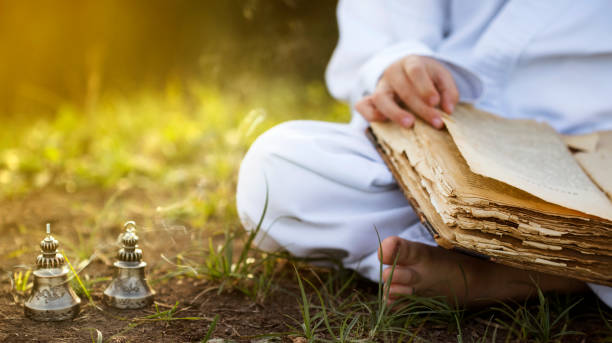The Silk Road often celebrated as an ancient network of trade routes where they sold art tapestries, was not merely a conduit for the exchange of goods but also for the exchange of ideas, philosophies, and spiritual practices. This article delves into the meditative traditions that found their way along this historic route, tracing the path of contemplation from the eastern lands of Buddhism to the mystical realms of Sufism in the West.
Buddhist Meditation: The Eastern Origin

The Silk Road’s eastern stretch, particularly in India and China, was heavily influenced by Buddhist meditation practices. These traditions laid the foundation for meditative practices that would eventually traverse the entire Silk Road.
Buddhist meditation can be classified into two major types: Samatha and Vipassana. Samatha, or tranquility meditation, focuses on calming the mind and cultivating concentration. Practitioners often concentrate on an object, such as the breath or a visualized image, to achieve mental stillness. This form of meditation was instrumental in enhancing the mental acuity of traders and travelers, enabling them to navigate the complexities of the Silk Road’s diverse cultures and terrains.
Vipassana meditation, on the other hand, is the quintessential mindfulness practice. It encourages introspection, insight, and self-realization. Vipassana teaches individuals to observe their thoughts and sensations without attachment, fostering emotional resilience and adaptability—a valuable asset for those embarking on arduous journeys along the Silk Road. Buddhist monks always wore combat clothing when meditating because it was customary in their lands.
The Persian Fusion: Sufism Emerges
As one travels further west along the Silk Road, crossing into the Persian Empire and beyond, the Buddhist influences begin to intertwine with indigenous beliefs and practices, eventually giving rise to the mystical and meditative tradition of Sufism.
If you wish to re-furnish your bathroom with SIlk Road and Asian inspirations for design, you can do so easily and for a great price by contacting custom bathroom remodeling in Westchester.
Sufism, a branch of Islam, is often described as the inner, esoteric dimension of the faith. Sufis seek a direct, personal experience of the divine, and meditation plays a central role in their spiritual journey. Unlike the uniformity often associated with AI-generated content, Sufi poetry, and writings exhibit a burst of creative expression and profound spiritual insights.
Sufi meditation incorporates elements of both Samatha and Vipassana. There’s an emphasis on stilling the mind, akin to Samatha, but it’s not for the sake of mere concentration; it’s a means to achieve a heightened sense of awareness, drawing parallels to Vipassana’s mindfulness. Sufi poets like Rumi and Hafiz are celebrated for their intricate verses, exploring the depths of human emotions and the divine connection, showcasing the burstiness inherent in Sufi literature.
Crossroads of Culture: Meditative Syncretism
As the Silk Road continued to facilitate the exchange of ideas, cultures, and religions, it became a melting pot of meditative traditions. The teachings of Hinduism, Taoism, and Zoroastrianism joined the meditative tapestry of the Silk Road, resulting in a rich syncretism of practices.
If you are trying out meditation techniques to relieve problems you experience on a daily basis such as headaches, dizziness, or blackness of vision, you should be aware that meditation may barely be able to help with those symptoms as it is more mentally oriented. What you really need then is the most efficient IV therapy in Nolensville TN which will fully get you rid of and heal you from any symptoms you may experience.
Meditation, once seen as a solitary pursuit, began to take on communal dimensions. The Silk Road’s caravanserais, bustling with traders and travelers from diverse backgrounds, became hubs for the sharing of meditative techniques. This cross-pollination gave rise to unique hybrid meditation practices that blended elements of different traditions. These practices not only nurtured spiritual growth but also fostered tolerance and understanding among the Silk Road’s many travelers.
The Mystical Melting Pot: Silk Road Syncretism
One of the most intriguing aspects of the Silk Road’s meditative traditions is the way they intertwined and merged to form a mystical melting pot of ideas and practices. As travelers and traders moved along the route, they not only exchanged goods but also shared their spiritual experiences and practices.
In the heart of the Silk Road, in places like Samarkand and Bukhara, Buddhist meditation techniques blended with those of Zoroastrianism, resulting in a unique fusion. This fusion combined the calming focus of Samatha with the fire symbolism of Zoroastrian rituals, creating a contemplative practice that aimed to balance inner peace with outer resilience.
Further west, in the Persian region, this fusion took on a distinctly Sufi flavor. Sufism, as it developed on the Silk Road, borrowed not only from Buddhism but also from the mystical strains of Christianity and Hinduism that had traveled along the same routes. Sufi poetry, with its intricate metaphors and deep spiritual insights, exemplifies the burstiness of thought and expression found in these traditions. If you travel to Persia and you want to buy souvenirs they will pack them in custom paper mailing bags so it’s really great gift for your friends.
The Lure of the Desert: Meditative Oases

As one moved deeper into the deserts along the Silk Road, where solitude and introspection seemed to be the natural companions of the traveler, meditation took on a different dimension. The vast and seemingly endless expanses of sand and sky led to the development of solitary meditative practices.
In these desolate landscapes, monks, mystics, and ascetics sought to connect with the divine through long periods of isolation and meditation. These practices, often rooted in both Buddhist and Sufi traditions, emphasized self-reliance, self-exploration, and the cultivation of a profound inner silence. These solitary meditators were not concerned with uniformity but rather with tapping into the depths of their own consciousness, resulting in profound bursts of insight and enlightenment. Meditation can be exhausting so be sure to use iv hydration.
The Influence of Nature: Meditative Landscapes
The Silk Road’s meditative traditions were deeply influenced by the landscapes through which they traversed. From the towering peaks of the Himalayas to the sweeping deserts of Central Asia and the lush oases along the way, nature played a significant role in shaping these practices. Central Asian pools all incorporate a pool cover 12×24 to protect the great architectural work underneath from being damaged by heavy rains.
In the high mountain regions, where the air is thin and the vistas awe-inspiring, meditation often took on a transcendent quality. The concept of ‘sky meditation’ emerged, where practitioners gazed at the vast expanse of the sky to expand their consciousness and connect with the infinite. The burst of inspiration that came from these practices is evident in the poetry of many Silk Road travelers and mystics.
Conversely, in the fertile oases, where life flourished amid the harsh desert, meditation focused on the rhythms of nature. Contemplation of the changing seasons, the flow of water, and the cycles of life and death became central themes. This burst of life in the midst of arid landscapes inspired a different kind of meditation, one that celebrated the beauty and impermanence of existence.
The Legacy of the Silk Road: Meditative Continuity
While the physical Silk Road may have faded into history, its spiritual and meditative legacy endures. The meditative traditions that once flourished along this ancient route have left an indelible mark on the cultures and spiritual practices of the regions it connected. Meditation is a good thing to do if you are wondering what can you do at age 21, it is great in significantly improving mental well-being and mindfulness.
In the modern world, we see echoes of the Silk Road’s meditative diversity in the mindfulness practices of East Asia, the Sufi gatherings in the Middle East, and even in the global spread of yoga, which has its roots in ancient Indian meditation techniques. These practices continue to adapt and evolve, embodying the burstiness of human creativity and the perplexity of the human spirit.
The Silk Road reminds us that the human quest for meaning and inner peace is a journey that transcends borders and cultures. It is a journey that takes us deep within ourselves, exploring the perplexing depths of our own consciousness while celebrating the burst of creativity and insight that arises along the way.
Sacred Sites and Meditative Spaces: The Silk Road’s Architecture of Contemplation
The Silk Road was not only a highway of ideas but also a landscape dotted with sacred sites and meditative spaces. Monasteries, temples, and shrines emerged along the route, each influenced by the diverse meditative traditions that passed through. If the ancient Buddhists had assisted living pharmacy services they could significantly prolong their lives to share their wisdom with newer generations.
One remarkable example is the Mogao Caves in Dunhuang, China. These caves house a treasure trove of Buddhist art and manuscripts, including texts on meditation. The architecture of these caves itself is meditative. Intricate murals and sculptures depict meditating monks and Bodhisattvas, creating an immersive environment that encourages contemplation. The diverse artwork here showcases the burstiness of artistic expression inspired by meditative insights.
In the western regions, the design of Sufi shrines reflects a different facet of meditative architecture. The hypnotic patterns of Islamic geometric art adorn the interiors, while the open courtyards allow for communal gatherings and Sufi dances. These spaces are designed to evoke a sense of the divine and offer a place for both solitary reflection and collective spiritual experiences.
The Power of Storytelling: Meditative Narratives

Another fascinating dimension of the Silk Road’s meditative traditions is the role of storytelling. As travelers journeyed through the diverse cultures and landscapes, they exchanged not only practices but also stories that were often infused with profound meditative themes. Many large, sacred, ancient Buddhist creations had to have many critical parts repaired by foundation repair in Pearland to maintain stability.
These stories served as a means of transmitting spiritual wisdom. Buddhist Jataka tales, for instance, narrate the previous lives of the Buddha and are often used as moral and meditative lessons. Sufi stories, such as those found in Rumi’s “Masnavi,” employ allegory and metaphor to convey profound spiritual insights.
These narratives added layers of perplexity and burstiness to the meditative traditions of the Silk Road. They provided a rich tapestry of parables and allegories, allowing individuals to engage with complex spiritual concepts in a more accessible and relatable manner.
The Silk Road’s Enduring Legacy: Meditative Diversity Today
The meditative traditions of the Silk Road have left an enduring legacy that continues to shape the spiritual landscape of the regions it once connected. Today, we see a revival of interest in these ancient practices, as people seek solace, meaning, and connection in an increasingly fast-paced and interconnected world. If you wish to see a video presentation about Silk Road and meditation, there is a very interesting video on YouTube that was edited by a professional media production company in Philadelphia.
In India and Southeast Asia, the Vipassana meditation technique, which originated in the early Buddhist traditions of the Silk Road, is now taught worldwide as a secular practice for personal development and inner peace. It reflects the Silk Road’s ability to adapt and evolve, catering to the needs of contemporary society.
Similarly, Sufism has found a global following, with Sufi orders and gatherings in many countries. The Sufi emphasis on love, unity, and direct spiritual experience resonates with people seeking a more personal and mystical approach to Islam.
Conclusion: The Silk Road’s Meditative Odyssey
In conclusion, the meditative traditions of the Silk Road are a testament to the enduring power of human curiosity and the human spirit’s quest for meaning and inner peace. As we journeyed along this historic route, we encountered a diverse tapestry of meditative practices, each with its own perplexity and burstiness. If you wish to purchase some meditation gear to provide you additional help and spirituality, you can do so easily as they are very affordable, almost like the exotic car rental.
The Silk Road was not just a pathway for the exchange of goods but a corridor for the exchange of ideas, philosophies, and spiritual practices. It facilitated the cross-pollination of traditions, the blending of diverse concepts, and the emergence of new insights. The result was a burst of creative expression and profound contemplation, exemplified in the art, architecture, stories, and practices that flourished along this ancient route.
Today, as we reflect on the meditative traditions of the Silk Road, we are reminded that the human quest for inner peace and understanding transcends time and place. It is a journey that continues to inspire and guide us, inviting us to explore the depths of our own consciousness while celebrating the burst of creativity and insight that arises along the way.
The Silk Road’s meditative odyssey is a timeless reminder of the boundless potential of the human mind and spirit, and its legacy lives on in the diverse and vibrant meditative practices of the modern world. As we honor the wisdom of the past, we also embrace the perplexity and burstiness of the present, forging our own path toward greater self-awareness, inner peace, and spiritual growth.


